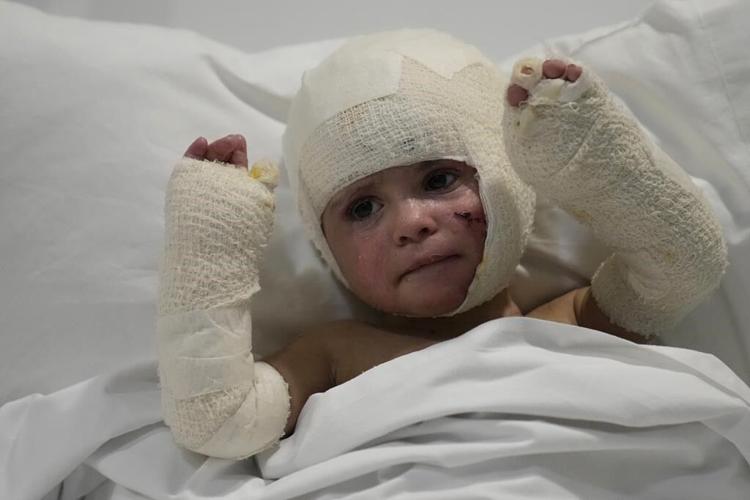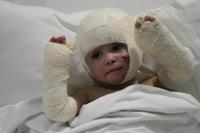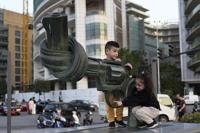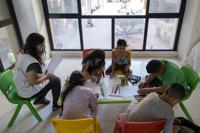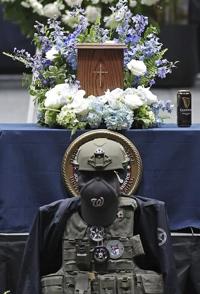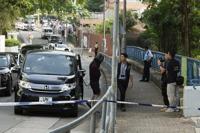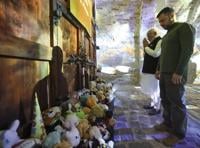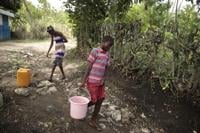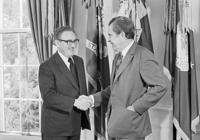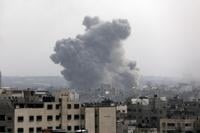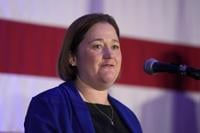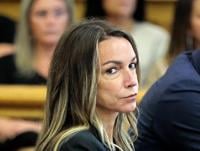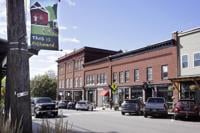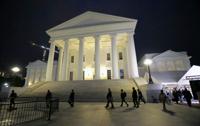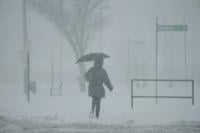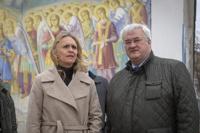BEIRUT (AP) — Curled up in his father ’s lap, clinging to his chest, Hussein Mikdad cried his heart out. The 4-year-old kicked his doctor with his intact foot and pushed him away with the arm that was not in a cast. “My Dad! My Dad!" Hussein said. "Make him leave me alone!” With eyes tearing up in relief and pain, the father reassured his son and pulled him closer.
Hussein and his father, Hassan, are the only survivors of their family after an Israeli airstrike last month on their Beirut neighborhood. The strike killed 18 people, including his mother, three siblings and six relatives.
“Can he now shower?” the father asked the doctor.
Ten days after surgery, doctors examining Hussein's wounds said the boy is healing properly. He has rods in his fractured right thigh and stitches that assembled his torn tendons back in place on the right arm. The pain has subsided, and Hussein should be able to walk again in two months — albeit with a lingering limp.
A prognosis for Hussein's invisible wounds is much harder to give. He is back in diapers and has begun wetting his bed. He hardly speaks and has not said a word about his mother, two sisters and brother.
“The trauma is not just on the muscular skeletal aspect. But he is also mentally hurt,” Imad Nahle, one of Hussein’s orthopedic surgeons, said.
Israel said, without elaborating, that the strike on the Mikdad neighborhood struck a Hezbollah target. In the war that has escalated since September, Israeli airstrikes have increasingly hit residential areas around Lebanon. Israel accuses the Lebanese militant group of hiding its capabilities and fighters among civilians. It vows to cripple Hezbollah, which began firing into northern Israel after Hamas’ Oct. 7 attack triggered .
But children have been caught in the midst.
With more strikes on homes and in residential areas, doctors are seeing more children affected by the violence. More than 100 children have been killed in Lebanon in the past six weeks and hundreds injured. And of the 14,000 wounded since last year, around 10% are children. Many have been left with severed limbs, burned bodies, and broken families — scars that could last for a lifetime.
Ghassan Abu Sittah, a renowned British-Palestinian surgeon who is also treating Hussein, sees that long road ahead. This is his worry: “It leaves us with a generation of physically wounded children, children who are psychologically and emotionally wounded."
‘What do they want from us?’
At the American University of Beirut Medical Center, which is receiving limited cases of war casualties, Nahle said he operated on five children in the past five weeks — up from no cases before. Most were referred from south and eastern Lebanon.
A few miles away, at the Lebanese Hospital Geitaoui, one of the country’s largest burns centers increased its capacity by nearly 180% since September so it could accommodate more war wounded, its medical director Naji Abirached said. About a fifth of the newly admitted patients are children.
In one of the burn center’s ICU units lies Ivana Skakye. She turned 2 in the hospital ward last week. Ivana has been healing from burns she sustained following an Israeli airstrike outside their home in southern Lebanon on Sept. 23. Israel said it struck ammunition depots and launchers in southern Lebanon that day when its warplanes launched hundreds of airstrikes in different parts of Lebanon, making it the deadliest day of the war so far. More than 500 people were killed.
Six weeks later, the tiny Ivana remains wrapped in white gauze from head to toe except her torso. She sustained third-degree burns over 40 percent of her body. Her hair and head, her left side all the way to her legs, both her arms and her chest were burned. Her family home was damaged, its ceiling set afire. The family’s valuables, packed in their car as they prepared to leave, were also torched. Ivana’s older sister, Rahaf, 7, has recovered faster from burns to her face and hands.
Fatima Zayoun, their mother, was in the kitchen when the explosion hit. Zayoun jumped up to grab the girls, who were playing on the terrace.
It was, Zayoun said, "as if something lifted me up so that I can grab my kids. I have no idea how I managed to pull them in and throw them out of the window. She spoke from the ICU burns unit. “They were not on fire, but they were burned. Black ash covered them. ... (Ivana) was without any hair. I told myself, `That is not her.'”
Now, Ivana's wound dressings are changed every two days. Her doctor, Ziad Sleiman, said she could be discharged in a few days. She’s back again to saying “Mama” and “Bye — shorthand for wanting to go out.
Like Hussein, though, Ivana has no home to return to. Her parents fear collective shelters could cause an infection to return.
After seeing her kids “sizzling on the floor,” Zayoun, 35, said that even if their home is repaired, she wouldn’t want to return. “I saw death with my own eyes,” she said.
Zayoun was 17 last time Israel and Hezbollah were at war, in 2006. Displaced with her family then, she said she almost enjoyed the experience, riding out of their village in a truck full of their belongings, mixing with new people, learning new things. They returned home when the war was over.
“But this war is hard. They are hitting everywhere,” she said. “What do they want from us? Do they want to hurt our children? We are not what they are looking for."
Attacks at home can be hard for kids to deal with
Abu Sittah, the reconstructive surgeon, said most of the children's injuries are from blasts or collapsing rubble. That attack on a space they expect to be inviolable can have lingering effects.
“Children feel safe at home," he said. "The injury makes them for the first time lose that sense of security — that their parents are keeping them safe, that their homes are invincible, and suddenly their homes become not so.”
One recent morning, children were playing in the courtyard of a vocational school-turned-shelter in Dekwaneh, north of Beirut, where nearly 3,000 people displaced from the south are now living. The parents were busy with an overflowing bathroom that serves one floor in a building that houses nearly 700 people.
Only playtime brings the children, from different villages in the south, together. They were divided in two teams, ages ranging between 6 and 12, competing to get the handkerchief first. A tiny girl hugged and held hands with strangers visiting the shelter. “I am from Lebanon. Don't tell anyone,” she whispered in their ears.
The game turned rowdy when two girls in their early teens got into a fist fight. Pushing and shoving began. Tears and tantrums followed. The tiny girl walked away in a daze.
Maria Elizabeth Haddad, manager of the psychosocial support programs in Beirut and neighboring areas for the U.S.-based International Medical Corps, said parents in shelters reported signs of increased anxiety, hostility and aggression among kids. They talk back to parents and ignore rules. Some have developed speech impediments and clinginess. One is showing early signs of psychosis.
“There are going to be residual symptoms when they grow up, especially related to attachment ties, to feeling of security,” Haddad said. “It is a generational trauma. We have experienced it before with our parents. ... They don’t have stability or search for (extra) stability. This is not going to be easy to overcome.”
New phases of life begin
Children represent more than a third of over 1 million people displaced by the war in Lebanon and following Israeli evacuation notices, according to U.N. and government estimates (more than 60,000 people have been displaced from northern Israel). That leaves hundreds of thousands in Lebanon without schooling, either because their schools were inaccessible or have been turned into shelters.
Hussein's father says he and his son must start together from scratch. With help from relatives, the two have found a temporary shelter in a home — and, for the father, a brief sense of relief. “I thank God he is not asking for or about his mother and his siblings,” said Hassan Mikdad, the 40-year-old father.
He has no explanation for his son, who watched their family die in their home. His two sisters — Celine, 10, and Cila, 14 — were pulled out of the rubble the following day. His mother, Mona, was pulled out three days later. She was locked in an embrace with her 6-year-old son, Ali.
The strike on Oct. 21 also caused damage across the street, to one of Beirut’s main public hospitals, breaking solar panels and windows in the pharmacy and the dialysis unit. The father survived because he had stepped out for coffee. He watched his building crumble in the late-night airstrike. He also lost his shop, his motorcycles and car — all the evidence of his 16 years of family life.
His friend, Hussein Hammoudeh, arrived on the scene to help sift through rubble. Hammoudeh spotted young Hussein Mikdad’s fingers in the darkness in an alley behind their home. At first, he thought they were severed limbs — until he heard the boy’s screams. He dug out Hussein with glass lodged in his leg and a metal bar in his shoulder. Hammoudeh said he didn’t recognize the boy. He held the child's almost-severed wrist in place.
In the hospital now, Hussein Mikdad sipped a juice as he listened to his father and his friend. His father turned to him, asking if he wanted a Spider-Man toy — an effort to forestall a new outburst of tears. He said he buys Hussein a toy each day.
“What I am living through seems like a big lie. ...The mind can’t comprehend,” he said. “I thank God for the blessing that is Hussein.”

